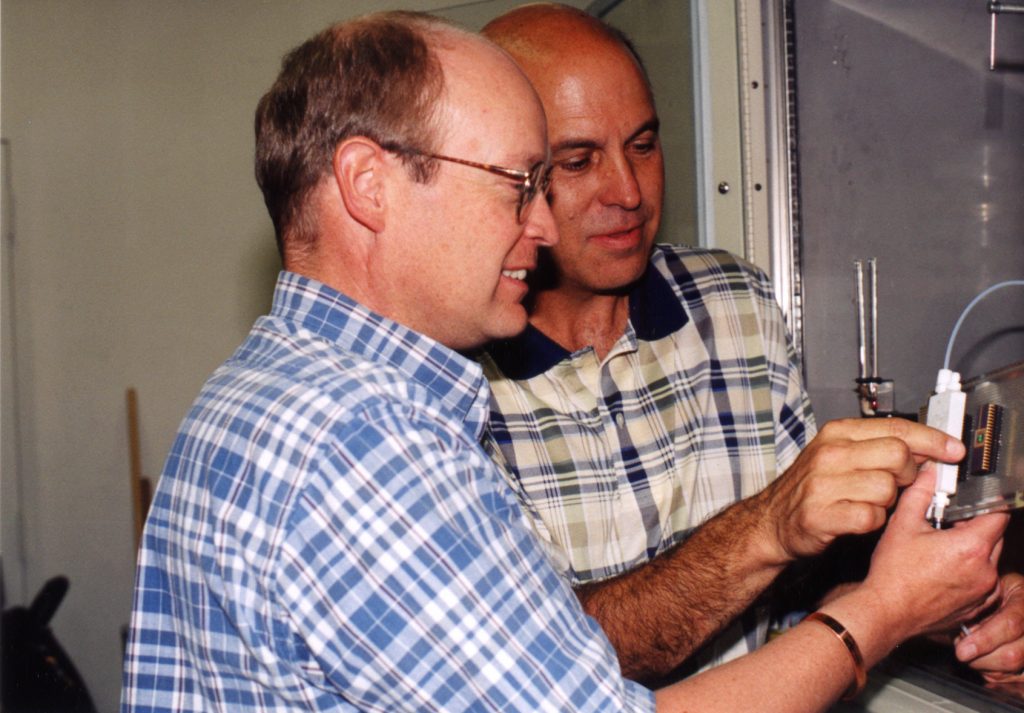
ALBUQUERQUE, N.M. — In a new approach to studying atmospheric corrosion on copper, researchers at the Department of Energy’s Sandia National Laboratories are putting multiple corrosion experiments on a single silicon wafer in a type of micro-laboratory.
The combinatorial experimental method promises to shed light on how and why copper corrodes. Conductive copper is essential to most electronic devices. Its corrosion can cause failure. Considerable interest exists both inside and outside Sandia to figure out ways to reduce copper corrosion and to predict the life of electronic components when it does.
The concept of combinatorial experimentation, where multiple experiments occur simultaneously and under the same conditions, has routinely been used in biomedical research, but not applied to characterize corrosion.
“In the past, whenever we did copper corrosion tests, we would put a piece of the copper into an atmospheric chamber, add contaminants at very low levels [ppm and less], and run the experiment,” says Charles Barbour, project principal investigator. “But this serial approach is very time intensive and we were unsure that the environment was the same experiment to experiment. It was difficult to compare results.”
The researchers’ efforts to understand copper corrosion are part of a Sandia initiative to develop analytical tools that predict corrosion behavior of both copper and aluminum in weapon environments. The investigation using the combinatorial approach is funded by Sandia’s Laboratory Directed Research and Development (LDRD) program.
A range of combinatorial experiments have been completed in various environments containing sulfide species and humidity. The results for one type of experiment that used microlab electrical-test structures are particularly noteworthy, Barbour says.
Researchers evaporated a thin copper film onto silicon wafers using an electron beam. They then etched away portions of the copper film using a photolithographic process that left thin “meander lines” of copper. The 16 lines formed “electrical resistors” used to monitor the extent of corrosion as a function of time. The resistive elements were ion-implanted with various impurities such as indium, oxygen, deuterium, and aluminum. During exposure to the environment containing less than a part per million of hydrogen sulfide, researchers calculated the thickness of the copper-sulfide corrosion product layer grown on the meander lines from the change in resistance.
The researchers discovered that indium slows corrosion whereas deuterium speeds it up.
“These experiments show it is possible to use micro-combinatorial techniques to efficiently characterize copper corrosion,” says Jeff Braithwaite, an expert in corrosion science. “Use of the small samples proved beneficial because the extent of corrosion could be easily monitored as a function of time and because all of the experiments could be simultaneously performed.”
Barbour says another important outcome of the parallel approach is that all 16 tests occurred simultaneously in the same environment. This condition eliminates issues concerning reproducibility of the corrosion environment. Thus, the micro-combinatorial technique leads to internal standards for determining relative corrosion behavior.
Simultaneous to running the experiment, former Sandian Jeff Nelson used the Labs’ supercomputing capabilities to calculate how copper would react to impurities actually used in the experiments. Results of the microlab experiments validated the physical mechanism proposed from the computational modeling.
“This finding shows our experimental approach is on the right track,” Barbour says. “We still have a long way to go with our combinatorial experiments and our modeling approach, but we’re moving in the right direction.”